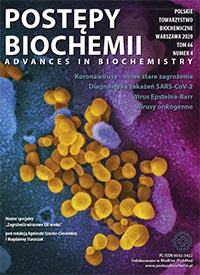Towards elucidating the structure, function, and druggability of coronavirus cis-acting RNA motifs
DOI:
https://doi.org/10.18388/pb.2020_362Abstract
Coronaviruses are the causative agents of mild to severe respiratory and intestinal infections
in humans. They are the largest RNA viruses, which genomes and encoded RNAs are known to fold into the highly-order structures that play essential roles in the viral replication and infectivity cycle. The recent outbreaks of new pathogenic coronaviruses steered researchersâ attention into the possibility of targeting their RNAs directly with novel RNA-specific drugs and therapeutic strategies. In this manuscript, we highlight the recent biochemical and biophysical methodological advancements that yielded more in-depth insight into the structural and functional composition of coronaviruses cis-acting RNA motifs.
We discuss the complexity of these RNA regulatory elements, their intermolecular interactions,
post-transcriptional regulation, and their potential as druggable targets. We also indicate the location and function of unstructured and highly-conserved regions in coronaviruses RNA genomes representing viable aims for antisense oligonucleotide or CRISPR-based antiviral strategies.
Downloads
Published
Issue
Section
License
Copyright (c) 2021 Advances in Biochemistry

This work is licensed under a Creative Commons Attribution 4.0 International License.
All journal contents are distributed under the Creative Commons Attribution-ShareAlike 4.0 International (CC BY-SA 4.0) license. Everybody may use the content following terms: Attribution — You must give appropriate credit, provide a link to the license, and indicate if changes were made, ShareAlike — If you remix, transform, or build upon the material, you must distribute your contributions under the same license as the original. There are no additional restrictions — You may not apply legal terms or technological measures that legally restrict others from doing anything the license permits.
Copyright for all published papers © stays with the authors.
Copyright for the journal: © Polish Biochemical Society.




